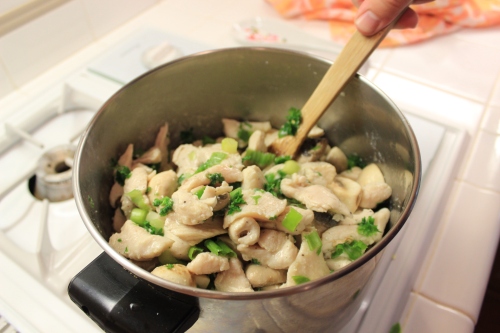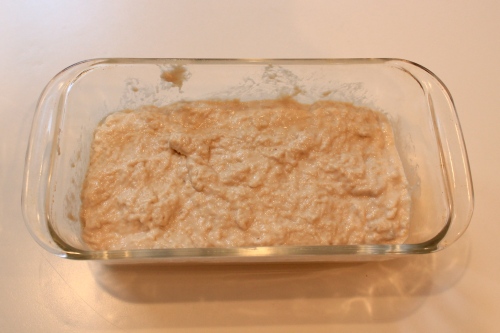Having consumed two lengthy 19th-century French novels recently, I thought it would be interesting to not only read about the French in the 1800s, but eat like them too. I decided to find a French recipe from the time period and cook it.
Easier said than done.
I don’t read French, so I needed a recipe that was already translated. I found an online newsletter called Sundries that focused on the 18th century, and had translated some French recipes from the period. It took me a while to sort through them—I passed over unsavory ones such as the pigeon tart, which calls for whole pigeons the cook must pluck and “truss”—but finally found some that looked reasonable. I decided to make three: an entrée, a bread, and a dessert.
The most difficult part of the process was figuring out how much of each ingredient to use, and the length of cook time. The instructions were so well-known that the authors often left these details out. I had to do a lot of translating myself, even though the words were already in English.
Having picked the recipes, I invited my family, grandma, and fiancé to join me, figuring that even if the meal was a flop, the flop would be more grand with a group of people. I was amazed (and pleased) with the result; I actually managed to make a successful 18th-century French meal.
Below are the original recipes, accompanied by my own notes. And pictures, of course.
Recipe #1: Napoleon’s Breakfast
The author who translated this recipe from the French made an interesting note. The recipe is named after Napoleon, who ate this dish for either breakfast or lunch—the records are unclear. But the recipe is missing from many post-Napoleon cookbooks. Why? Napoleon lost the war, and after the king returned to the throne, it was dangerous to be known as a Bonapartist. People were shunned and sometimes even thrown in prison for their political standing. No wonder his favorite meals disappeared from the cookbooks.
Put salt, pepper and a good lump of butter in a pot. Heat it, then put in your chicken cut up in pieces, brown it over a brisk flame, stirring well.
Then let it simmer to finish cooking. When the chicken is almost done, add a glass of white wine, spring onions and parsley chopped up fine, pieces of mushroom, salt and pepper. Let it boil a quarter of an hour, adding a little wine if the sauce boils away too much. This done, lay your pieces of chicken out on a dish, and cover them with the sauce. You can also add a little lemon juice.
See what I mean? No directions for how much to use of any of the ingredients. Even so, the entrée was the easiest of the three dishes I tried. The instructions are fairly straight-forward and easy to follow.
I figured “a good lump” of butter would be about three or four tablespoons, so I started with that and added the other ingredients. I also didn’t know how much a “glass” of white wine would be, so I used one cup. From the recipe, it sounds as if the sauce should be thick, but it’s really just the wine, so it ended up very watery. But the mushrooms and parsley worked well with the chicken and the white wine, and the dish tasted good.
Recipe #2: French Bread
Take half a peck of fine flour, the yolks of six eggs and four whites, a little salt, a pint of ale yeast, and as much new milk made warm as will make it a thin light paste, stir it about with your hand, but be sure you don’t knead them; have ready six wooden quarts or pint dishes, fill them with the paste, (not over full) let them stand a quarter of an hour to rise, then turn them out into the oven, and when they are baked rasp them. The oven must be quick.
This recipe required quite a bit of research (what’s a peck?), and then some modifications. I did cheat a little and looked up several modern French bread recipes to reference the amount of certain ingredients.
A peck happens to be 37 US cups, which means the recipe calls for 18 and a half cups of flour. I thought maybe the translator had made a mistake, but the rest of the ingredients seemed to match these proportions. Six eggs? And there was no way I was going to use two and a half cups of yeast. The result would look like Lucy Ricardo’s attempt at baking.
In those days, each family had to make everything themselves. There were no grocery stores they could visit to pick up a loaf of bread. This recipe reflects the practice of baking large batches all at once so they would have enough bread to last them a week or more.
I didn’t need enough bread for two weeks; I only needed enough for one night. So I used only one sixth of the recipe. This translated into three cups of flour, one egg, etc., which was more reasonable. Using a sixth of the yeast called for would have been half a US cup, so I modified that further and used only one teaspoon.
I also had to guess at how much “a little” salt was, and how much warm milk to add to make a light paste. After adding two cups of milk, my paste wasn’t very light or thin, but I didn’t want to add too much, so I stopped there and hoped for the best. This is how it looked pre-oven:
The only instructions for how long to cook the bread are “when they are baked rasp them. The oven must be quick.” I looked up “rasping” and discovered it means scraping. This is the part when the baker scores the bread to keep it from breaking or cracking at a weak spot. But this usually takes place before baking, not after. And I had no idea how long a “quick” oven was.
I kept a careful eye on the oven while the bread was inside, and after 42 minutes at 350 degrees, the bread was done!
 It was surprisingly light—not a dense bread. Everyone seemed to like it; we ate almost the whole loaf.
It was surprisingly light—not a dense bread. Everyone seemed to like it; we ate almost the whole loaf.
I still have one more recipe: the desert. But that one’s a doozy, so I’ll save it for the next post. Stay tuned!




Leave a comment